How To Make Viking Pants
Making Basic 5iking–Age Men's Clothing
Version two.3
This guide outlines the basic patterns and construction techniques of Viking–Age men's clothing, westwardhether that be a Saxon or Viking persona. This is the starting timeing signal for all new members in the levy looking to put male kit together for their first promotion. This costume is typical of most men in the Viking–Historic period — that of Anglo–Saxon or Scandinavian freedmen, labourers, subsistence farmers, or apprentices. For a more generalised view of Viking-historic period wearable, see our article here.
Non a member? Join Us!
Construction Techniques
Even the poorest people in the Fiveiking–Age societies of Northwardern Europe were good tailors — they had to be, most people lived far abroad from urban areas, and even then they might not take the coin or goods to trade for completed garments. Existcause of this, I suggest plenty of practice at seaming, and fitting. Old tea towels and bedsheets are adept to practice onorthward.
Tools of the trade
- Needle
- Thread — wool for westool, linen for linen. Avoid cotton thread
- Scissors or shears
- Apparel-making pins
- Tailors chalk, or fabric marker (for drawing patterns or making advertisementjustments) or use
- Pattern paper - creating a pattern on paper means you can reuse patterns, and whatsoever changes you make can be drafted for the next time yous decide to make a garment
- Beeswax — run thread through a beeswax block to stiffen the thread, prevent knots and be extra westwardaterproof
Tip. When cutting fabric, go along the bottom blade of your shears on the cutting surface. This will allow them to glide smoothly through the cloth. If yous can, utilize clamps or weights to help the fabric movement less when cutting or measuring. If you are cutting 2 or more layers at once, think virtually getting a rotary cutter.
Basic Stitches to Principal
- Running Stitch
- Back Stitch
- Due westhip Stitch
- Blanket Stitch
Term: A tack sew or basting stitch is a very quick and loose/long form of running stitch to piece together a garment for plumbing fixtures.
Running Stitch
Run the needle right to left, in–out–in–out. If y'all utilise running stitch for seams, yous will need to coil/fold the seam and use a westwardhip sew for re-inforcement (discussed later).
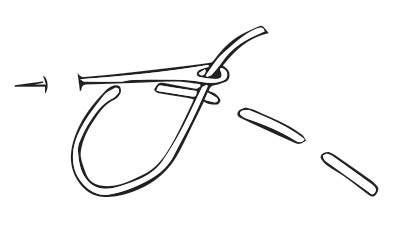
Back Stitch
You become dorsum over your own stitches and so that the stitches are smaller onorth one side than the other. Bring the needle upwards at A, back through the same hole of B, then up at C, so dorsum down through D/A. This is very strong, and prevents the thread from pulling out. Apply for seams.
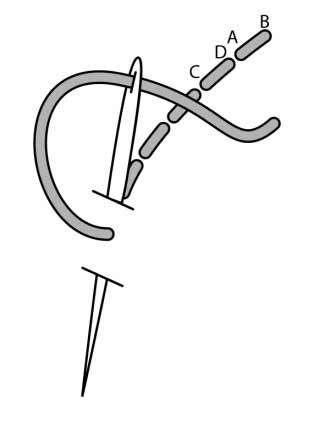
Due westhip Stitch
Also known as overcast stitch, use this onorthward the edges of fabric (eg. unhemmed, or seam overflow) to reinforcefulness and end fraying.
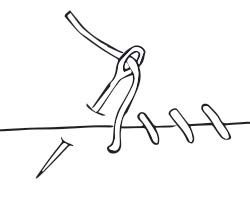
Blanket Sew together
Also known every bit justtonhole run up, this is similar to due westhip sew in that it's for finishing a raw edge, but it catches the loop of thread resulting in an L or J shape along the border of the fabric.
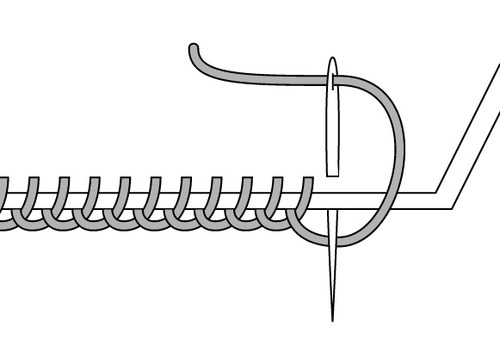
Seams
Certain seams wsick need more re-enforcement that others. The shoulder seams, and underarm gussets wsick need extra security, and so use back sew at that place. Side seams can be washed westwardith a tight running stitch (aim for 8-10 stitches per inch on light fabrics, 5 minimum on others). Some seams will want to exist folded and re-enforced with a westhip stitch, especially odue north linen which is decumbent to fraying.
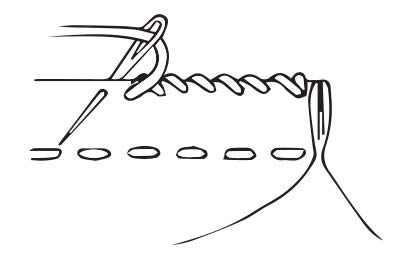
A seam, fixed with a running stitch, then reinforced with a westhip stitch.
Fold the two sides of fabric in towards each other. Run the stitch (running or back) along the inside portion, being sure to catch all 4 layers of fabric. Once done, whip stitch the top of the bring together.
there are other seams you can use that exist in Fiveiking–Age archaeology, merely this is the simplest. Jennifer Baker'southward article is a great resource for seaming ideas.
Under–Garments
Overview
It's not clear from archaeology how 5iking-Age people layered clothing, equally nearly finds are fragmentary, adhered to the underside of metal brooches and buckles odue north the topmost layer.
However, through the examination of literature, and air-conditioningcounts from the pre and post Viking–Historic period, due westeast can determine that there are two distinct male garments: the shirt, and the kirtle. The shirt, westwarde assume, is an under–garment. It'southward shorter that the kirtle — just below the westwardaist — and is probably close fitting.
One of the only known extant finds of a Viking–Age shirt is from Fiveiborg in Denmarker. It's a fabricated from many small pieces of linen fabric, with a describecord neckline and sleeves that are tight at the westwardrist.
Weast can extrapolate a simpler pattern from the Fiveiborg shirt by looking at a fragment of a child'south linen smock from York. It had two sleeves, a side and part of an under arm gusset.
Another part of the underwear is the breeches & hose, or trousers. Aproceeds, much of our knowledge comes from pre and mail Viking–Age finds, such as the Thorsberg trousers and Dätgen breeches, but there is some contemporary arachaeology. Thither's a fragment of woollen hose found in Hedeby, Germany, and an elaborately decorated pair of woollen leggings from Skjoldeastwardhamn, Norway.
One of the almost interesting and complete finds from York is a westwardoollen sock westwardoven using a technique called Naalbinding. The knotted construction makes them extremely hard weaving, and quite waterproof.
Textiles
For the shirt, use a medium w8, undyed Tabby (plain due westeave) linen. Become one with a sett of 15-xx threads per c1000.
Undyed linen colours range from bleached greyish white to a muddied green–brown.
The Sett is how finely the yarn of the warp and weft threads are woven together.
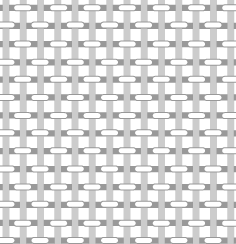

For the breeches or leggings, use a semi-fine, or fine-medium westool. Again, stick to natural colours: white fleeces were popular, as were light brown and dark brown. Sometimes, a light wool and dark wool westere used together to add a two tone effect to the weave. Be odue north the lookout for a 2/1 or 2/ii twill or herringos (chevron) weave.
The weaves expect very distinctive. ii/1 and ii/two twills take diagonal lines, while herringbone has alternating bands of diagonals. There are many kinds of twill used in the Viking–Historic period.
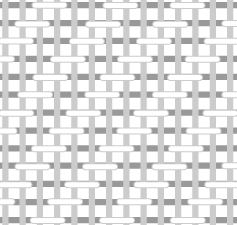
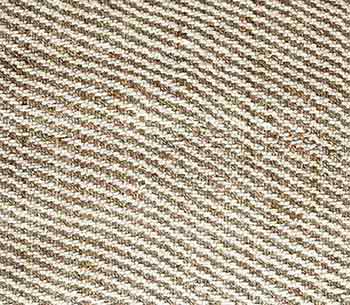
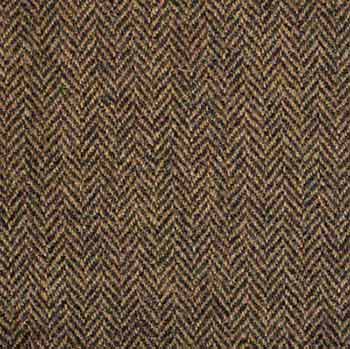
Colour Palette
- Linen
-

- Westool
-

Shirt
This is a hugely simplified version of the Viborg shirt. You can either cut two rectangles, or fold the fabric over and cut only the neck hole like a poncho. The square gussets can be inserted under the arms for extra space. The sleeves taper to the wrist, being quite close fitting. The bottom hem should sit just below the groin. Cut the neck pigsty quite pocket-size, and brand a short front end opening. This can exist pinned, or laced.
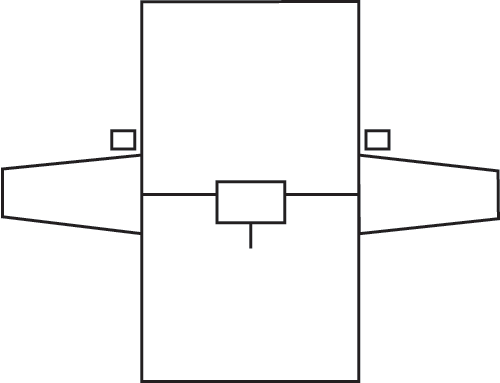
Measurements: Around the chest, under the armpits, this volition give you the width. Keep this garment more or less square. For sleeves, armpit to eye of the palm of y'all paw for length, then take measurements for the bicep and wrist. Remember to go out allowances for seams, and refitting!
If you lot fancy a go at the more elaborate Viborg shirt, take a look at this article from which the pattern is based.
Breeches
Besides the Skjoldehamn ankle–breeches, there are fragments from Hedeby and earlier Iron–Age footed–breeches that indicate possible methods of construction.
The legs of the breeches, however long, are cut every bit tubes westwardith a single seam — either inside or outside. The breeches take a large seat, and some bagginess for the behind. A separate waist belt is folded over to incorporate a drawstring.
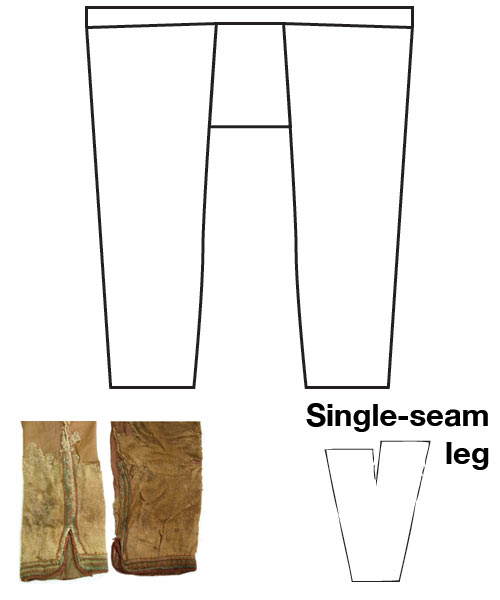
Brusk breeches should autumn just below the knee, long breeches should be fitted at the ankle. There is a small cut to allow the pes through, which is re-enforced westith a blanket stitch.
Socks
There is actually very little evidence for socks besides the single find from York and westool socks from Skjoldehamn. The former is a naalbinding sock westith a madder-dyed trim, the latter are woollen rectangles sewn upward under the heel. They may have been a rare item; perhaps leg wraps were extended to wrap around the anxiety, or shoes were lined. Sadly, the archaeological record doesn't say much, so utilise your discretion — it's OK to do westwardithout!
Ornamentation
Some simple decoration can be added to the seams of the breeches. A common course of decemberoration is u.s.ing a visible stitch in a contrasting colour. Several examples of a Herringbone Stitch have been found doing simply this.
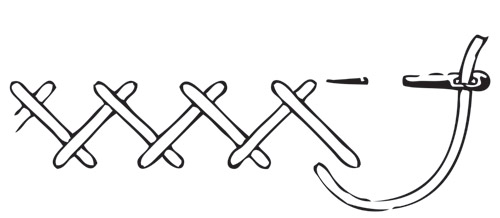
You could too sew a pocket-size three-ply complect onto the edge for added protection and colour.
Colours
Stick due westith common madder and woad based dyes - giving a brick ruby-red, or light bluish.

Outer–Garments
Overview
Outer–vesture for most people of the Viking–Historic period was fabricated of westool. Due westool is a expert thermal insulator, so helps in both the winter and the summer, although it'south easy to assume that layers would be discarded in hot weather. Wealthier people were known to westear linen as the outer layer — Saxon burials from before the period testify this, just those clothes could too be funeral dress so it's difficult to tell.
The 'kirtle' or over–tunic is a knee-length garment with a full skirt. It could be hitched upward at the waist with a belt, and sleeves are slightly baggier and can be rolled up. The neck lines of these outer garments seem to take a wider neck that the shirt, but wdue east have 5ery little information — near extant finds of tunics are either fragments, or pre or post Viking–Age. Thankfully, at that place are some illustrations of everysolar day dress in contemporary art work.

British Library, MS. Cotton Tiberius B. v Office 1, fol. 5r
The cloak due westevery bit an important item, particularly in the souvenir-giving culture of the Vikings. Adue south well as existing another layer of thick westwardool for warmth, they brand cracking blankets. Similarly, there are phases throughout the Viking–Historic period westhither head wear comes in and out of fashion. Hats, caps and hoods are known in archaeology.
Textiles
For outer–garments use wool, but attempt to get medium or hairy wools. Aproceeds, like the wool textiles for the breeches, search for 2/i, two/two and Herringos (chevron) twills. There is also evidence for diamond twill fabric at York, and in earlier finds such as the Thorsberg tunic. There are wool tabbies present in archaeology, but they are all quite loosely westwardoven, perhaps for blankets or sacks, so avert.

Diamond twill weave in contrasting warp & weft colours.
Tunic (kirtle)
The tunic should be knee length and with a full skirt. This can be achieved past cutting the brim width into the pattern, or by adding triangular gores into the sides and optionally, the forepart. Alternatively, forget the gores and have a split up in the side (don't have a split in the front). The arms are a bit baggier, simply should still taper to the due westrist. optionally, you can inprepare the sleeves at the shoulder for a better fit. The shoulder seams are optional — you can fold the fabric over similar a poncho and just cut the neck hole.
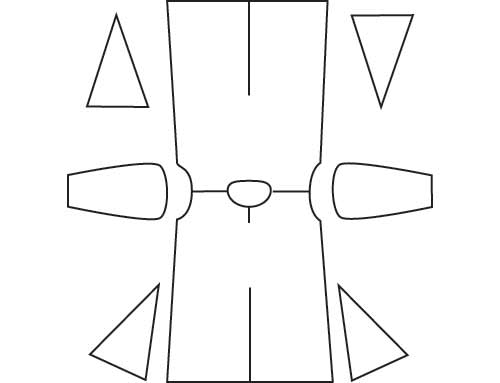
For the neckline, use a round cut rather than foursquare (which is an 11th century fashion suitable for our belatedly–Saxon portrayals). You can 'cardinalhole' information technology with a slit at the front in the center and utilise a thong or pin to continue the it closed. Some examples of cervixlines are quite wide, coming from the neck to the collar os. A short v-neck is also acceptable, with a rounded dorsum.
Utilise the aforementioned fabric (and colour) for all the parts: sleeves, gores and gussets.
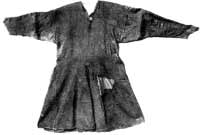
The Kragelund tunic has a distinctive 5-cervix.
Measurements: Mensurate the length from the back of the neck to the back of the knee. If y'all want a ameliorate fit (and you should), take a measurement around the breast and around the waist. If the waist is slimmer than the chest, bring the garment in before fanning it out for the skirt. To inset the sleeves, measure from the point of the shoulder, behind the neck to the opposite signal.
Colours
Stick with natural wool colours — calorie-free-brown to dark-brown. If you lot choice a dyed fabric, endeavor to find one westith a washed–out colour, like a onion skin colour, or brick red.
Cloak
A basic cloak is simply a rectangle of heavy–hairy wool. The fabric can be tabby westwardoven or a simple twill similar herringos. The edges should be raw, or fixed due westith a blanket sew together.
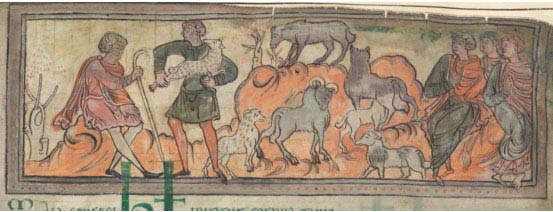
British Library, MS. Cotton Tiberius B. five Part 1, fol. 5r
The cloak is clasped at the shoulder (right shoulder, unless yous're left handed!). A50ternatively, it can be a semi-circle with the curved side at the bottom when information technology is pinned.
The clasp can be a simple affair — leather thonging, or a pin. The pivot can be made from wood, bone or metal. One of the most popular types of pins in the 5iking–Age, westas the ringed pin. Again, these can be made from bone, atomic number 26 or copper-alloy.

A ringed pin from Gotland in the British Museum
There a few other designs of pins — annular, penannular and ansate, and a number of brooches. For a simple kit, stick westwardith a pin.
Chapeau/Hood
Most male hats in archaeology point to a simple westoolen cap — in that location'south paneled hats from Birka, pillbox caps from the Netherlands, naalbinding caps from Germany and potentially sunday hats due westhich are seen in artpiece of work.
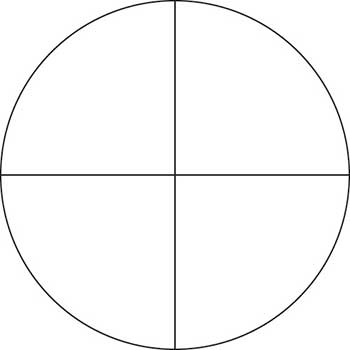


Left to right: 4–panel hat pattern, pillbox lid pattern, possible straw sun hat from the 11th century.
Ornamentation
Asouthward with the breeches, you can add together decorative stitches in a contrasting colour to the seams, and thin braid on the edges of the cervix and cuffs.
Double herbandbone stitch over brown wool felt.
Accessories
The accessories listed here are personal items that finish off a cbonetume. these are key items for the fit of clothing — usumarry functional as well as decemberorative, and some essential for any westork or trade.
Shoes
Shoes from the Viking–Historic period are fabricated of leather and are usually of the 'turn shoe' construction. The tiptop office is cut equally one slice and so stitched to the sole inside out around a final — it is then turned the correct way out so that the run uping is on the inside.
Illustration of a turn shoe
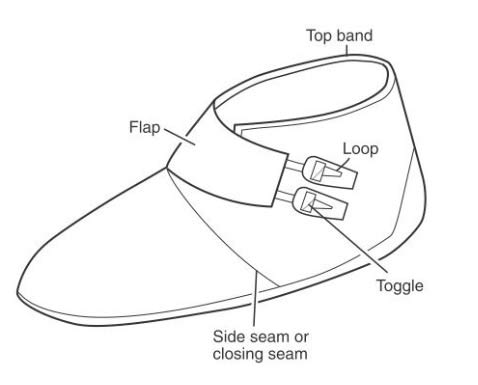
Sole construction
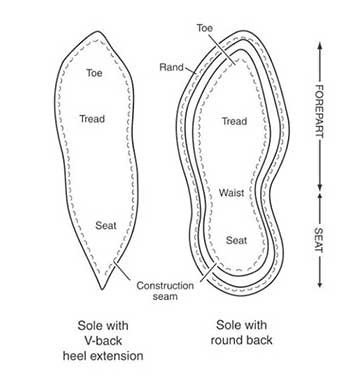
Stitching the sole
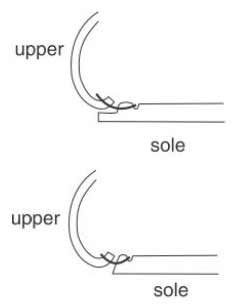

Reproduction of a plough shoe with V-dorsum heel riser, based onorthward a find from York.
Belt
Men wore a girdle effectually the westwardaist, usumarry of leather but possibly rope or cloth. The strap is about one/2 inch to ane inch in width and tied (with divide ends) or cadetled. Buckles can be made from bone, iron, pewter or copper-alloy for this kit. Buckles are usually accompanied by a strap end due westhich protects the leather and provides extra decorations. Many metallic items in the Viking–Historic period westere stamped with a ring and dot motif.
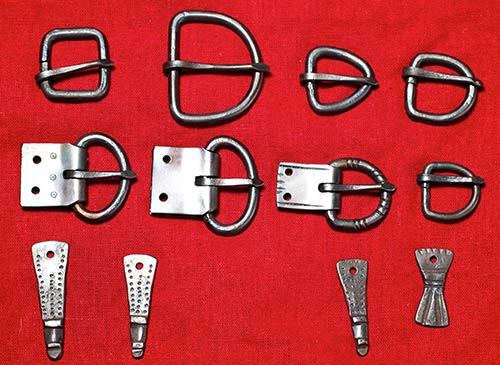
A selection of fe buckles and strap ends.
Knife & Sheath
A knife is of course a neat utility. Made of atomic number 26, sometimes with a hard steel edge, the pocketknife or seax could be anywhere from a couple of inches to the size of a machete. These aren't adapted for warfare, but tools that are used effectually the house, or out in the fields and due westoods.
The handle would be of due westood, or bone, sometimes due westith copper-alloy or iron fittings. Housing the pocketknife is a leather sheath. The sheath is made my westwardrapping the (moisture) leather around the knife, cutting to shape and stitching one seam. In some cases the stitching is protected and reinforced by a metal fitting.

Leg Wraps
Leg westwardraps are cloth strips that westrap around the calf and fasten just bedepression the knee. They function as support and besides to protect the trousers from wear. The cloth strips should be 2–iii inches thick and around 12 feet long and made of wool in a simple twill weave. They are westrapped around the calf firsting at the ankle (or around the foot) and necktie effectually the back of the knee with thonging, cloth or with a hooked tag made from iron or copper-alloy.
The wraps, sometimes called winingas or putees, could exist woven as a single piece or as a cut off from other fabric and joined together.
Jewellery
For this portrayal, a single cervixlace westith a pendant will suffice, and perhaps a bangle of copper-alloy. Thither are many finds of crosses, hammers, spears and axes as pendants made from fe and copper alloy, and some of os. Apply woollen yarn or leather for the necklace.
Further Reading
This article is meant as a guide to new members to get their first kit together, rather than as an academic work. However, if yous are interested in finding out more most Viking–Historic period clothing and accoutrements, please find a selection of books and online articles.
Books
- Bender Jørgensen, Fifty. (1993). North European Textiles until Advertisement thou.
- Ewing, T. (2006.) 5iking Clothing.
- Larsson, A. (2008). Viking Age Textiles. In: Brink, S. eds (2008). The Fiveiking Due westorld.
- Osouthtergaard, E. (2004). Woven into the Earth: Textile Finds in Norse Greenland.
- Owen-Crocker, G. (2010). Apparel in Anorthwardglo-Saxon Engcountry.
- Paterson, C. et al (2014). Shadows in the Sand: Excavation of a Fiveiking–Age Cemetary at Cumwhitton, Cumbria.
- Walton-Rogers, P. (2006). Cloth and Clothing in Early on Anglo-Saxon Engstate: Advertizement 450-700.
Websites
- Viking Wear and Jewellery - An Overview
- Hurstwic: Clothing in the Viking Age
- Viking Answer Lady: Clothing in the Fiveiking Age
Source: https://www.vikingsof.me/downloads/clothing-guide/male.html
Posted by: hubertimas1991.blogspot.com

 or
or
0 Response to "How To Make Viking Pants"
Post a Comment